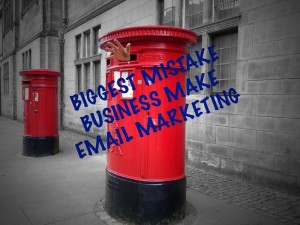Business owners, just because you can send customers a pretty graphics heavy email doesn’t mean you should. Both Mailchimp and Aweber two of the larger email marketing tools online allow you to create both HTML and text ver sions emails, BUT.
sions emails, BUT.
Which is the best to use for business, plain text or HTML?
Awebers discuss the issue in this blog post “should I use text or html” but I beleive they misses the major point, CONVERSION.
Conversion is the process of persuading someone to change their status. For example from website visitor to email list member or from visitor to customer are both examples of conversions. Opening an email or clicking a link are actions or steps in the conversion funnel but are not a conversion.
A conversion increases the value of the recipient in the sales funnel moving them from one status to another. Making a member of an email list into a customer provides value. Moving them from customer to repeat customer provides value. Having them share content increases brand recognition and reach, which provides value.
It’s unlikely that an HTML email will contain the ablitliy to enable a recipient to change their status while reading the email. In general the conversion is going to take place on another platform as a result of following a click action, visiting a referred URL or some real world action
Here are the typical email conversion steps and where they occur:
- Email transmission (outgoing email server)
- Email reception (incomming email server)
- Email open (in email)
- Call to action (in email)
- Action complete (sales platform)
- Conversion tracked (sales platfrom)
Each of these steps are possible breaking points in the conversion funnel.
Successful email transmission requires a good white listed mail server capable of performing the bulk email in a timely fashion. It’s capacity to do so will be reduced by the size of the email it has to repeatedly send. HTML emails are generally 2-5 times larger than text only emails so they have 200% + more chance of causing a bulk email transmission failure.
Once transmitted, assuming the destination address is correct, emails have to pass through the receiving mail server and email client. Both will almost certainly have some form of spam filtering. Text emails tend to pass through these filters more easily than HTML, simple because they contain fewer possible spam elements.
Once visible in the recipients email client, regardless of device the user has to decide to view the email by opening it or at least stopping long enough on the email for it to render in the preview pane of their email client.
Our studies have shown that open rates are directly related to brand recognition and subject line and have very little to do with HTML. Of course if the brand image has setup an expectation that the email will contain something good to look at then an HTML email is required to continue that expectation and maintains open rates.
Once opened the email’s CTA and copy has the job of transitioning the recipients from the email to the conversion platform (most typically a landing page or sales page on a website). Once there it’s the platforms funnel and copy that must move the recipient through the process to completion. Only then is a successful conversion recorded against the email funnel.
Open rates and click actions have their value in determining where the weak points in the funnel hide but they contain very little value with out conversion. A high open rate but no conversions is just as valuable as having no open rate at all. No conversion = no transition and therefore no value.
People will try and tell you that open rates and clicks are all valuable. That opens mean increase in brand recognition and clicks show engagement but that’s all untraceable here say. Unless a email marketing campaign results in some recipients transitioning from their current state to a new state in your sales process these metric have no value other than helping you identify where the funnel is most likely broken.
Once you have conversions then they start to have value as comparative indicators from email to email to which subject, or CTA and copy works better than the other within your market segment.
So in my opinion the faster you can move recipients from their email client to your conversion page the better. We have found that HTML emails with just text and hyperlink CTA ‘s do the best job. They load fast, they appear above the fold and are responsive without any need for special coding. They are quicker and easier to write giving you the opportunity to concentrate on great copy and not on graphic design. They render in all the major email clients in a consistent way which isn’t something you can say about HTML emails that contain fancy layout designs.
Your landing page is the place to put the fancy stuff, images and layout design. Browsers are built to display those graphical element why repeat that effort in an email its unnessecary and most email clients can’t do it justice.
But don’t take my word. See what the best digital marketers do, sign up to a few of the best digital marketing expert, newsletter or offer. Examine their email marketing campaigns and you will be see simple text based HTML emails with superb subject lines and great copy. Designed to get you to take action and away from your email client and onto their conversion platform as quickly as possible. Shouldn’t your business be using simple text only HTML email marketing campaigns that focus on conversion rather than opens and clicks?
